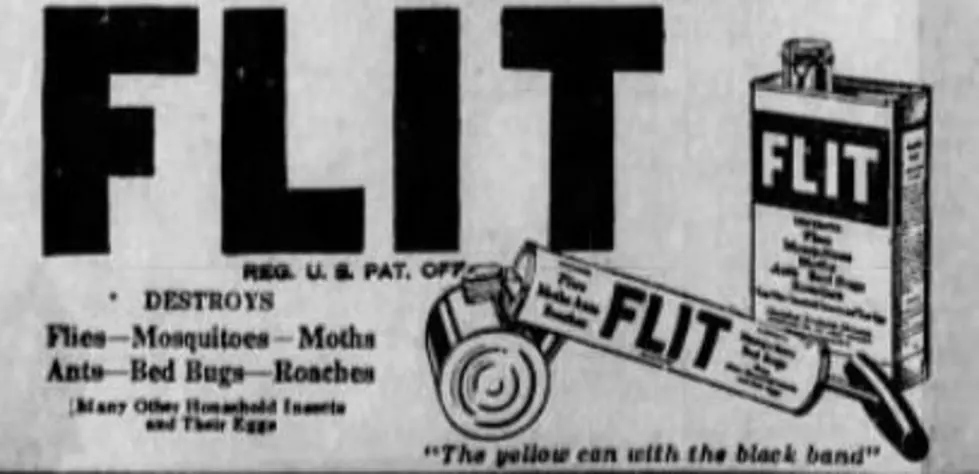
Harmon’s Histories: Montanans have battled mosquitoes with dubious concoctions, aerial attacks
Mosquitoes bothering you? No problem!
In the good old days of summer, you simply reached for your can of “Skeeter Skoot” or “Fly Knocker.” Then again, perhaps you might have preferred Standard Oil’s new offering called “Flit.”
Advertising for Flit, the “yellow can with the black band,” declared: “Flies are filthy and dangerous insects. Flit spray clears the house in a few minutes of mosquitoes and disease-bearing flies. It is clean, easy to use, and harmless.”
Well, as time would reveal – some of those sprays were not harmless at all.
For decades sprays included things like arsenic (in “Paris Green”), mineral oil and eventually – in the 1940s – DDT. They were marketed as modern-day science at its best, dispensed by the iconic hand atomizer.
Flit’s ads announced, “More than seventy formulas were tested before the final selection was made. Flit is a 100% effective insecticide containing no inactive (inert) ingredients.” Heavy duty stuff!
Another brand, “Fly-Tox,” trumpeted its development at the Mellon Institute of Industrial Research. Safe? You bet! In fact, you were told to “spray directly on clothing and hosiery.”
Oh, let’s not forget super-strength “Tanglefoot” fly spray. Yes, it cost a little bit more than “ordinary liquid insecticides” but remember – it was “super-strength!”
The military was always looking for ways to prevent soldiers from contracting malaria and other insect-borne diseases.
In 1946, the USDA printed a booklet outlining research done on “DDT and other insecticides and repellents developed for the armed forces.”
It tested “several thousand materials,” concluding that DDT “has been outstanding in performance.”
By the 1940s and 1950s, entire communities were being aerial-sprayed with DDT. On June 10, 1948, Great Falls residents were informed through local papers that “An army plane with an 800-gallon tank and spraying equipment will start operations Thursday.”
In Kalispell, Colonel Ralph Sleator who was in charge of the city spraying campaign, announced in the summer of 1951 that “a second spraying had been made in some areas surrounding Kalispell,” and that more spraying might follow soon within the city.
In the southern Bitterroot Valley, Sula residents reported “there have been practically no mosquitoes since” the Forest Service had used B18s and other aircraft in a massive 10-day DDT aerial campaign to eradicate spruce bud-worms from the surrounding forests.
Forest Supervisor Thurman Trosper was on hand to personally oversee operations. He reported DDT spray “sprinkled over the hood” of his car and another nearby vehicle, calling that a clear sign that “close coverage of the infested timber was being obtained.”
Growing up in Libby, I clearly recall the summertime aerial attacks – watching from my bedroom windows as the spray planes dowsed the town including our house and yard. Of course, once it was over – we were outside playing again!
According to the EPA, “DDT (dichloro-diphenyl-trichloroethane) ... was initially used with great effect to combat malaria, typhus, and the other insect-borne human diseases among both military and civilian populations.”
But by the 1960s and 1970s, it had become clear that the chemical was doing more harm than good, and “in 1972, EPA issued a cancellation order for DDT based on its adverse environmental effects...DDT is classified as a probable human carcinogen by U.S. and international authorities.”
Today, “DEET (chemical name, N,N-diethyl-meta-toluamide) is the active ingredient in many repellent products,” according to the EPA, which says, “The human health risk assessment concluded that there are no risks of concern because no toxic effects have been identified when used as a dermally applied insect repellent, and there is no dietary or occupational exposure for DEET.”
For those inclined to avoid manufactured chemicals, many reports indicate Oil of Lemon Eucalyptus (OLE) and Picaridin may be options, along with Cinnamon oil and Catnip oil.
I wonder if stores still sell mosquito netting? (The answer is yes.)
Happy camping and recreating!
Jim Harmon is a longtime Missoula news broadcaster, now retired, who writes a weekly history column for Missoula Current. You can contact Jim at harmonshistories@gmail.com. His new book, “The Sneakin’est Man That Ever Was,” a collection of 46 vignettes of Western Montana history, is now available at harmonshistories.com.
